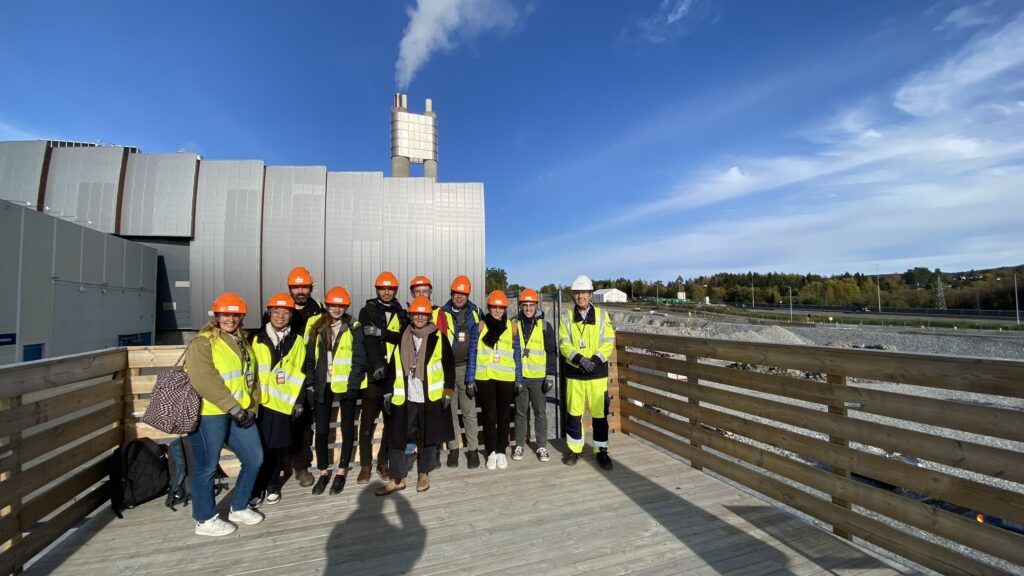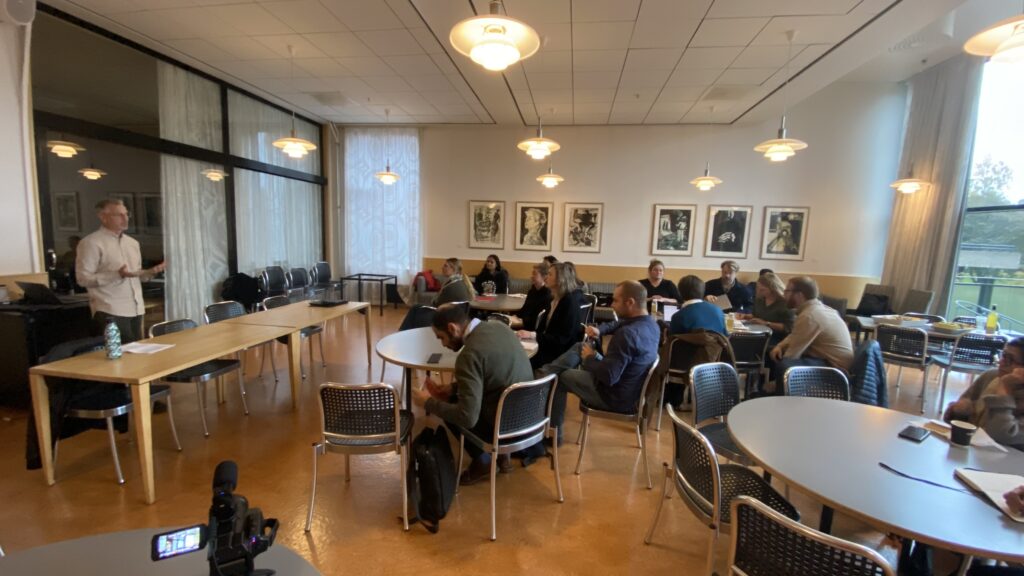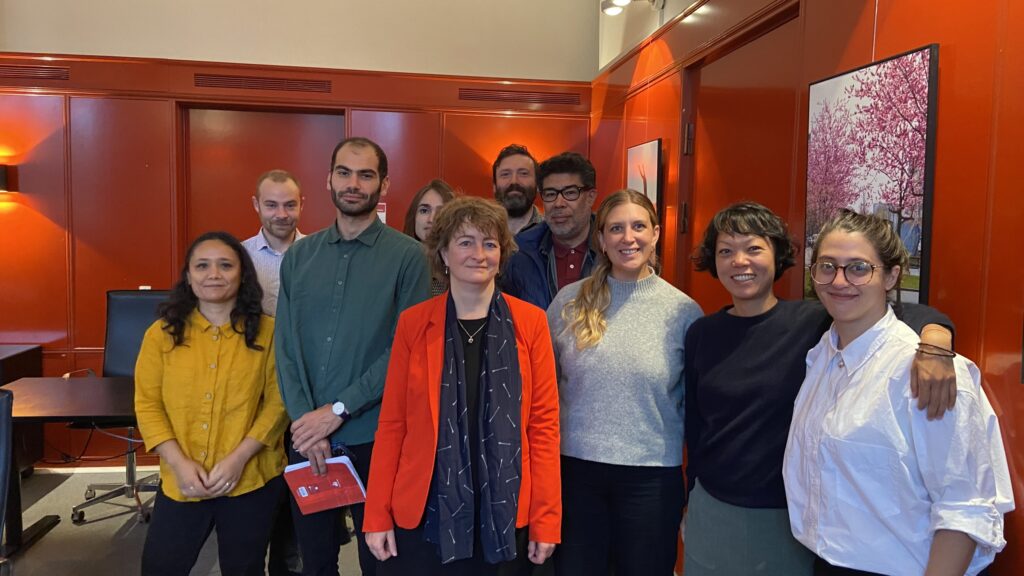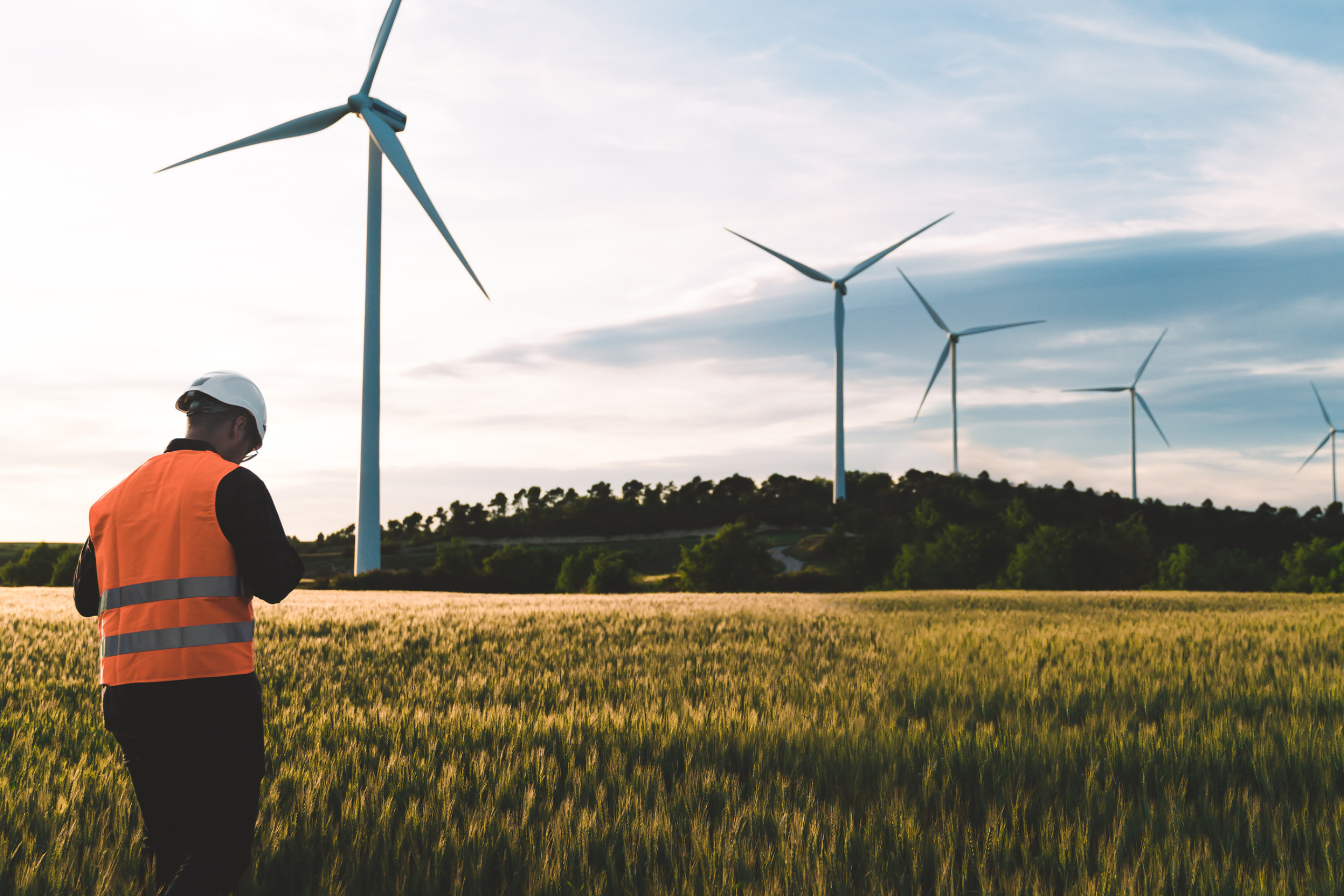For many, Scandinavia is synonymous with social democracy, high union density, public ownership, and progressive governments inclined to climate action and sustainable policies. A recent study tour to Norway and Denmark, hosted by Rosa Luxemburg Foundation’s New York and Brussels offices, found that both countries still struggle with entrenched interests – local and international – holding back a genuine “just transition.”
The five-day study tour in October brought ten experts – legislators, researchers, and activists – from North America and Europe to Norway and Denmark. It was the aim of the tour to explore the renewable energy landscape in Scandinavia, and to exchange experiences from both sides of the Atlantic around building a “just transition”: a greening of the economy in a fair and inclusive manner that creates decent work opportunities and leaves no one behind.
Taking as its starting point the role and strategies of left parties, trade unions and climate justice groups in the Nordic region, the visit also looked at the larger challenges, including the regional and global dynamics surrounding a green transition. The results were challenging, and sometimes inspiring, but contradictory.
Leading on Renewables?
Denmark and Norway are rightly seen as world leaders on renewable energy, but this status is riddled with incongruities. While Norway’s hydro sector supplies over 99 percent of the country’s electricity needs and is more than 90 percent state-owned, wind power faces significant public opposition. Unlike hydro, onshore wind generation in Norway is 75 percent privately owned, largely exported for profit, and pays lower taxes than other energy sectors. Offshore wind production – which faces less criticism – mostly serves to electrify Norwegian oil and gas platforms.
Opposition to onshore wind has even emerged within Norway’s environmental movement and indigenous Sámi population, most notably around the Fosen wind farm in central Norway. In October 2021, Norway’s Supreme Court ruled the wind farm had been built in clear violation of the Sámi people’s human rights, but the government has failed to take any action. Both environmental groups and the Sámi people continue to protest against the wind farm, and the case has only helped deepen public opposition to wind energy in the country.
Denmark’s Wind Revolution
Unlike Norway, wind is integral to Denmark’s national electricity production, and is now responsible for over 55 percent of domestic electricity consumption. The sector has grown up in the past four decades, in part thanks to government support and incentives, improvements in technology, and the involvement of Denmark’s important cooperative sector. Tellingly, however, a major expansion in wind energy in the 1990s was driven by take-up from individuals, rather than by government-led utilities, while easy loans from cooperative banks have also allowed a large number of students to invest in the wind sector.
While Denmark has been putting up windmills for 40 years, it has only been in the past five years that the market has finally shifted focus to renewables. Wind is now such good business that Danish left-wing parties like Enhedslisten (The Red/Green Alliance) can demand investment in much larger developments. In one such recent massive offshore wind agreement, which has 20 percent state ownership – on a par with state involvement in oil and gas projects – they have succeeded inserting progressive social clauses along the production chain.
Denmark now hopes to become an energy exporter – although this is a goal of the industry, rather than of the left – and within 10 years, Denmark could be producing six times its domestic energy needs. Indeed, much of Denmark’s excess wind energy is already exported to Norway and Sweden as part of a regional market, but 30 percent of wind energy produced in Denmark’s Jutland region is also reserved for export to Germany at fixed rates, something which can lead to serious fluctuations in Danish energy prices.

Energy Islands and Exports
As the Danish wind sector continues to grow – particularly offshore – opposition to onshore wind farms has been building at the local level, especially in the face of unexpected bureaucratic problems. Proximity to onshore wind farms is increasingly being cited as reason not to refinance mortgages, for example, leading to negotiations about compensation for those living near such projects. While compensating local residents with corporate money is in line with the principles of a just transition, it is unclear how long private investors are willing to engage with this, and the government shows little ambition to invest in wind and solar by itself.
An increasingly popular idea among policy makers for avoiding such local opposition is moving energy generation to artificial “energy islands” offshore – an approach that has seen limited success. Bornholm Energy Island, with 50 percent state ownership, will export two-thirds of its energy to Germany, effectively subsidising Germany’s green energy transition with Danish tax funds – not a popular concept. The artificial island concept is not limited to energy either. Another of such project, Lynetteholm – designed to protect Copenhagen from sea level rise – faces strong opposition at home and in Sweden, over both the pollution from construction, and the threat it poses to the entire Baltic Sea, where it could alter the salinity by blocking vital underwater channels.
Hydrocarbon Hypocrisy
For all its wind energy, however, biomass actually makes up more than half of Denmark’s “renewable” energy profile, with carbon accounting rules. The Danish biomass sector is reliant on wood pellets imported from the Baltic Sea region and North America, much of them failing certification standards. Indeed, one of its larger wood pellet suppliers, Enviva, is facing collapse amid a massive greenwashing-scandal over revelations the company has been using whole trees, rather than waste wood, and causing widespread deforestation. Despite this, Denmark continues to fund the industry’s expansion and lobby for it at an EU level.
Nevertheless, as the wind energy sector has grown, Danish reliance on North Sea oil and gas has dropped, and in 2020 the government announced to great fanfare that it would stop granting permits for oil and gas exploration in the North Sea, and drilling would end by 2050. Despite this, Denmark continues to permit new hydrocarbon projects in the North Sea. One such – the Hejre oil and gas field, 300 kilometres off Denmark’s west coast – will produce up to 51 million barrels of oil over its lifetime. It is expected to begin in 2024, with production peaking in 2027.
“An Oil Company with a State”
In Norway, the carbon contradictions are – incredibly – even starker, with the country’s economy still heavily dependent on its massive hydrocarbon industry, epitomised by the state-owned energy company Equinor. Oil and gas export revenue has formed the backbone of Norway’s immense sovereign wealth fund and its welfare state, and the sector employs some 150,000 people. As a result, Equinor exerts near-hegemonic influence over Norwegian politics, economy and society. This remains the case despite Norway’s more radical stance on climate on the international stage. While ostensibly figuring among the nations most supportive of climate action at the recent COP summit, the same day as the final COP agreement was adopted, Norway’s energy minister promised it would change “nothing” for Norway, as “Europe is going to need a lot of energy”.
Indeed, many Norwegians wryly explain that while the Norwegian state once had an oil company, now the oil company has a state. Equinor has made itself appear integral to the viability of Norwegian society, successfully cultivating the idea that phasing out hydrocarbons would destroy the welfare state and the “Norwegian model”. As a result, there is a deep unwillingness in Norway to discuss phasing out oil and gas for fear of risking the country’s economic and social stability. Any just transition in Norway will require breaking this nexus between state, unions and capital around the oil industry, and convincing workers that their income, welfare, and standard of living will not be put at risk.
What About the Climate Movement?
Unfortunately, but perhaps understandably, in the face of such an influential hydrocarbon industry, Norway’s environmental groups are weak. They have little contact with trade unions, and researchers and activists are often dismissed by workers as an out-of-touch Oslo “elite”. As a result, the movement has failed to insert itself into Norway’s decision-making process, dominated by tripartite cooperation between government, business and the unions. In some ways the climate movement’s more successful public profile has reinforced this disconnect, with many Norwegian oil workers reporting feeling disempowered in the public sphere, and that their efforts to reduce emissions while guaranteeing Norway’s welfare state, remain underappreciated.
Norway’s “Bridge to the Future” alliance – created in 2013 with the aim of uniting trade unions and environmental groups (a similar alliance, with the same name, has since been forged in Denmark) – has taken on the challenge of overcoming division and distrust between workers and environmentalists. It has recently set-up regional groups to involve workers in the transport, gas, forestry, and other industries outside of the cities in the discussion. Likewise, Norwegian left-wing think-tank Manifest is working to identify the main issues and language that trigger hostility from either side, and bringing youth climate leaders to industrial sites – including oil platforms – to build mutual trust and foster practical dialogue on a sustainable and just industrial policy.

In Denmark, on the other hand, the climate justice movement has played an important role in shaping Danish climate discourse and demands. In 2019 – led by an articulate layer of young activists – it helped to push strong climate demands onto the agenda of both the broader left and the government itself. The climate plan championed by radical left party Enhedslisten and other Danish left parties was successfully translated into an ambitious national target of 70 percent emissions reductions by 2030. Since then, however, the momentum in Denmark’s streets has ebbed away, after a centre-left government adopted radical-sounding but often hollow positions, the momentum in Denmark’s streets has ebbed away, and tacit acceptance has crept in around questionable “solutions” to the crisis, such as carbon capture.
Missing Climate Targets
Denmark’s 70 percent emission reductions target has proved much easier to adopt than to realise, and with no clear climate action majority in the Danish parliament, genuine action has remained elusive. During negotiations, however, the left was also able to win agreement on the creation of an independent Climate Council. This group of experts and academics are instructed to evaluate Denmark’s emission reductions trajectory twice a year, and the government is required to respond promptly with an analysis of emissions and an appropriate policy response. Little real action ensues, but at least such failure is never far from public scrutiny.
While there is a broad consensus around the climate target, not everyone agrees on who should have to pay for it, and Denmark has chosen to rely heavily on higher green taxes and other market mechanisms to drive change. Here, at least, Denmark has avoided taking an entirely regressive approach due to the “green cheque” – actually introduced over a decade ago – a tax credit compensating low-income earners for the burden of higher climate taxes. Even so, with Denmark’s heavily-polluting hydrocarbon and agriculture sectors still fiercely resistant to change, and wielding significant influence, this progressive policy remains little more than window-dressing.
Norway’s climate target – 55 percent emission reductions by 2030, and net zero by 2050 – is yet another example of smoke and mirrors. The country’s official climate emissions calculations exclude Norway’s enormous oil and gas exports, which produce approximately equivalent to ten times the country’s domestic emissions. Despite such a hefty global responsibility and global calls for a move away from fossil fuels, the Norwegian government dismantling its hydrocarbon sector. On the contrary, Norway actually portrays its support for the fossil fuel industry as a vital component of its climate goals, shifting focus onto the development of Carbon Capture and Storage (CCS) as “a crucial tool for the industry”.
The Carbon Capture Distraction
Indeed, Norway – like the US – has fully embraced “tech” fixes such as carbon capture, developing a 25 billion NOK (2 billion euro) CCS strategy – the “Longship” project – to provide large-scale commercial offshore CO2 storage for companies and states across Europe. Norway’s flagship for this project is the Hafslund Oslo Celsio waste-to-energy plant, majority-owned by Oslo municipality. Despite considerable public funding, however (primarily from the Norwegian state and EU’s Horizon 2020 funds) the plant was obliged to privatise 20 percent of the plant’s equity to progress, and continues to face difficulty securing funding. During the delegation’s visit, the company also admitted the project would require much more energy to operate at scale than it presently consumes, raising questions about future costs.
Denmark, too, is betting on CCS – recently announcing 26.8 billion DKK (3.6 billion euro) in state aid on CCS projects over the next 15 years. The EU is also facilitating the CCS industry as part of its “European Green Deal”, creating a market in “carbon storage units”, with corporate CO2 “takeback” obligations, and consequently entrenching CCS in EU “climate action” for years to come. This pro-CCS agenda was also inserted into the final text at the COP28 in Dubai, despite the technology being unable to operate at the scale and speed necessary. Again, Norway was at the heart of this push, going so far as to invite corporate proponents of CCS to the summit instead of the climate researchers and experts it would normally bring.
“Green” Macro-Economics – Friend or Foe?
The European Green Deal (EUGD) itself – introduced in 2019 as an ambitious policy package to achieve carbon neutrality by 2050 – faces criticism as being insufficient, interfering with genuine climate action, and causing economic friction. Norwegian unions warned the delegation that the tug-of-war between the US Inflation Reduction Act (IRA) and the EU’s response, the Green Deal Industrial Plan (GDIP), was affecting Norwegian industrial workers, as several Norwegian companies consider moving operations to the US. The Carbon Border Adjustment Mechanism – viewed by some outside the EU as a unilateral trade barrier – and EU electricity market reforms were also raised as ostensibly good policies that could lead to contradictory outcomes locally.
Within the EU, new developments in Denmark’s wind energy sector are closely tied to new streamlined permit regulations and financial incentives in the EUGD and GDIP. Danish energy company Orsted’s contract with the state of New York to provide approximately 900 MW to the state energy system, for example, is under threat from rapidly rising costs due to supply chain complications and macro-economic factors attributed to the IRA. These, and other, examples were raised with delegates to underline the fragility of a global model where the deployment of renewables is largely in the hands of private, profit-driven multinationals, steered by contradictory, or even competing, regulatory schemes.
Copenhagen’s Ambitious Climate Plan
At a local level, other initiatives have also proved promising, but face similar problems. In 2012, Copenhagen Council set itself an ambitious climate target – aiming for carbon neutrality by 2025 – and many elements of its plan are now well within reach. This is particularly the case for energy production, while reducing consumption has continued to be challenging, leading Council to work with building owners and Copenhagen’s widespread cooperative housing sector to identify solutions. Municipal mobility targets – especially on car use – also continue to lag, worsened by a council majority that is opposed to reducing car ownership in the city and has redirected efforts redirected towards electric vehicles (EV) and flawed technologies like CCS.
The explosive growth of the EV market in Denmark is a good example of the dangers of poor planning. An incoherent rollout of infrastructure – including a shortage of charging stations and a variety of often-incompatible sockets – has hindered EV usability. Restrictions have also been placed on charging EVs at Danes’ much-loved summer houses, where the energy infrastructure is simply insufficient for demand. In Norway, economic incentives have encouraged an uptake of EV but have worsened social inequality and undermined public transport.
Despite the challenges, Copenhagen has seen its emissions reduced by 80 percent since 2010, and an expanded 2035 climate plan is now being developed. With no one to emulate, however, the Council is still determining how to implement its ambitious target successfully and with popular involvement. Central to its strategy is the holding of citizens’ assemblies to ensure widespread public input into, and ownership over, the plan. Left party Enhedslisten, who is overseeing the plan, also hopes this approach will help ensure more equitable outcomes, particularly around housing affordability in Copenhagen, which is experiencing an ongoing crisis.

A Just Transition, or Just Transition?
Despite the apparent success in developing their renewable energies sector, and some success in reducing emissions, vested interests in both Denmark and Norway continue to hold back a genuine change. In Norway, the hydrocarbon industry maintains a stranglehold on the public sphere that is unlikely to loosen any time soon. In Denmark, high levels of wind energy cannot hide a failure to address other polluting industries, including one, which was not the subject of the delegation’s focus during this visit: agriculture. So long as this resistance continues, any transition – socially just or otherwise – risks capture by corporate interests more interested in short-term profit than long-term gain.
These failures are no longer attributable to a lack of knowledge – the scientific consensus that climate change is real and is accelerating at an alarming pace, has been public knowledge for decades. However, where governments have acted, they have done too little, too much in the interest of private business, and the oil and gas sector in particular. This tension remains an ongoing part of the struggle for a genuine, socially just transition in Denmark, Norway and beyond. Its success depends on building deeper, stronger relations between environmental movements, workers, farmers, and communities. In this regard, as in the field of energy production, Denmark and Norway have much to teach, but they are no guiding lights. Like the rest of us, they have also still much to learn.
Duroyan Fertl is a former political advisor for Sinn Féin and the European United Left/Nordic Green Left (GUE/NGL) in the European Parliament. He is currently Nordic Countries Coordinator for the Rosa Luxemburg Foundation’s Brussels Office.



